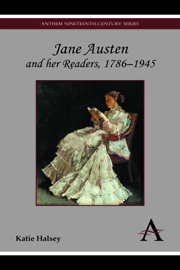Book contents
- Frontmatter
- Contents
- Acknowledgements
- Part One
- Part Two
- Introduction
- 4 Austen's Readers: Contexts I
- 5 Austen's Readers: Contexts II
- 6 Austen's Readers I: Affection and Appropriation
- 7 Austen's Readers II: Opposition and Resistance
- 8 Austen's Readers III: Friendship and Criticism
- 9 Austen's Readers IV: Sociability and Devotion
- Conclusion
- Notes
- Bibliography
- Index
Introduction
from Part Two
Published online by Cambridge University Press: 05 July 2012
- Frontmatter
- Contents
- Acknowledgements
- Part One
- Part Two
- Introduction
- 4 Austen's Readers: Contexts I
- 5 Austen's Readers: Contexts II
- 6 Austen's Readers I: Affection and Appropriation
- 7 Austen's Readers II: Opposition and Resistance
- 8 Austen's Readers III: Friendship and Criticism
- 9 Austen's Readers IV: Sociability and Devotion
- Conclusion
- Notes
- Bibliography
- Index
Summary
In the previous chapters, I suggested that Austen's novels provide models of resistance and change for a hypothetical reader, through what William Galperin calls the ‘counter-hegemonic practices of reading’ she makes available. I also proposed the argument that these practices were grounded in gender-related strategies of indirection. In my argument, the hypothetical reader recognizes the tension between, for example, Pride and Prejudice's realistic social criticism and its final ‘aesthetic gratification’, or Mansfield Park's apparent conservative moral ideology and its complicated intertextual structure, resisting collusion with the norms of taste that the novels set up. Reading in this way, I have argued, is both strenuous and ludic. For the hypothetical reader, reading, as Johanna M. Smith puts it, is ‘not passive consumption’ but instead a form of production.
But did Austen's actual historical readers take up the teasing challenges of her prose style? Discussing Richardson's Clarissa, Ruth Perry argues that ‘Clarissa got under the skin of women of Richardson's generation because, as with Lady Mary Wortley Montagu, their lives provided the raw materials for his imagination’. Clarissa, in other words, represented women readers to themselves. Austen's novels, drawing on and rewriting Richardson, also ‘got under the skin’ of their readers (and still do). Both troubling and consoling, they, like Richardson's, reflect the experience of intelligent, articulate women in cultural situations unsympathetic to their intelligence and eloquence. Unlike Clarissa, Austen's novels provide happy endings for such women, thus holding out the possibility that society can accommodate, even reward, women like Elizabeth Bennet, witty, impertinent and eloquent.
- Type
- Chapter
- Information
- Jane Austen and her Readers, 1786–1945 , pp. 89 - 100Publisher: Anthem PressPrint publication year: 2012



